If you have bladder control issues, you’ve likely experienced the anxiety that comes with trying to make it to the restroom or waking up needing to pee.
You may be wondering if your bladder problems are due to vaginal birth, weight changes, diabetes, or just getting older. But another likely and very common scenario is the genitourinary syndrome of menopause (GSM). As the name suggests, GSM is a name for the changes that occur in the vagina, labia, urethra, and bladder in menopause. GSM is very common, and symptoms can start in your 30s or 40s in perimenopause.
At Interlude, our medical team is here to provide information on key research, lifestyle changes, and medications to help you reduce incontinence, enjoy everyday activities, sleep better, and decrease the need for liners and pads.
Highlights:
- Menopause leads to a decline in estrogen levels and this can cause bladder control problems
- Bladder control issues can affect women starting in perimenopause and last for the rest of their lives
- Vaginal estrogen can be an appropriate treatment for incontinence, if you also have menopause vaginal symptoms
- Lifestyle changes can significantly improve bladder control
The link between menopause, estrogen, and bladder control
From birth to menopause, estrogen plays an important role in the function of the female body. But when estrogen levels decline through menopause, significant changes can occur to the vagina, labia, urethra, and bladder.
As a result of these changes, many women experience what’s known as the genitourinary syndrome of menopause or GSM. GSM affects up to 85% of postmenopausal women and symptoms can start in the perimenopausal years.(1) GSM can lead to issues like vaginal dryness, frequent UTIs, and pain with sex, but it can also really impact the way that you pee.
There can be other reasons for urinary incontinence besides menopause. But keep in mind, GSM is not only very common, it’s underdiagnosed and undertreated.(1) Only 7% of women receive prescription treatment (2). This means that many women in perimenopause or menopause are either managing anxiety around incontinence, avoiding everyday activities, or shopping for liners and pads.
How do hormonal changes affect my urethra, bladder, and pelvic floor?
When estrogen levels decline in perimenopause and menopause, the urinary system might not function like it used to.
- Hormonal changes to the urethra and bladder. Loss of estrogen in menopause can cause the changes to the bladder smooth muscle function. These changes can lead to loss of bladder control, or bladder urgency, frequency, or burning with urination which is called dysuria.
- Loss of pelvic floor support. Pelvic floor muscles are like a hammock that supports the urethra and bladder. When estrogen levels decline in perimenopause and menopause, the pelvic floor muscles can weaken, and this can lead to leakage.
Why does this happen? The bladder, urethra, and pelvic floor all have estrogen receptors, and this means that the hormone estrogen plays an important role in the function of the entire urinary system.(2) When your body stops producing estrogen, you may have problems with these organs and their function.
How does menopause lead to urinary incontinence?
Research shows that menopause is associated with bladder control problems such as frequency, urgency, nocturia, and urge incontinence.(3) 40% of post-menopausal women are affected by overactive bladder.(4) 70% of women with urinary incontinence have symptoms that began at the same time as menopause.(3)
There are two main types of incontinence: overactive bladder and stress incontinence.
Overactive bladder
If you have overactive bladder, your symptoms can include:
- Urge incontinence,
- Increased frequency, or having to pee more than 6 to 8 times a day.
- Increased urgency, such as a sudden and intense need to pee.
- Waking up in the middle of the night to pee, which is also called “nocturia”.
Urgency or urge incontinence is a type of urinary incontinence that’s associated with menopause, and it’s a hallmark symptom of GSM. But experts aren’t entirely sure of the cause of urge incontinence. It can be due to changes in the nerves or the muscles.
Stress incontinence
Stress incontinence is quite common, stereotypically due to pelvic changes after having a baby. But people can have stress incontinence without having had a baby.
The primary cause of stress incontinence is a weakened pelvic floor. The Menopause Society states that stress incontinence is more common starting in perimenopause, but doesn’t tend to worsen in menopause. If you have stress incontinence, urine leakage can be triggered by:
- Exercise
- Coughing
- Sneezing
- Laughing
- Lifting heavy objects
Mixed incontinence
Mixed incontinence is a combination of both stress incontinence and urge incontince.
UTIs and bladder control problems
UTIs can lead to bladder control problems because UTIs cause bladder irritation. Interestingly, frequent UTIs can be caused by loss of estrogen during menopause and are also a hallmark symptom of GSM.
Menopause hormone therapy and incontinence
There is some data to show that women who take systemic menopause hormone therapy may be more likely to develop incontinence.(5) However, there are some weaknesses in the research.(1)
Menopause hormone therapy is often not enough to address GSM symptoms. Additional treatment like local vaginal estrogen is sometimes needed.
Prescripton vaginal estrogen for incontinence
Vaginal estrogen is not just for menopause-related painful sex or vaginal dryness. It can also treat overactive bladder.
Vaginal estrogen is a prescription medication that’s available as a cream, suppository, or ring. It's a local therapy, meaning it is only applied to the vagina, and helps strengthen the tissues in the vagina, urethra, and bladder.
Several studies have found that vaginal estrogen improves symptoms of urinary urgency and frequency in women.(6, 7, 8, 9) One randomized controlled trial found that vaginal estrogen is as effective as oxybutynin at reducing urinary frequency and improving incontinence in postmenopausal women with overactive bladder.(10)
Prescription oxybutynin for incontinence
Oxybutynin is an oral medication that’s used to treat symptoms of an overactive bladder, such as urinary incontinence or frequency. Oxybutynin works by decreasing muscle spasms of the bladder. However, this type of medication is associated with side effects like blurry vision, dry mouth, and constipation. 71% of people who try oxybutynin will stop using it.(12)
How to limit bladder irritation
Avoiding certain foods can prevent bladder irritation and urgency to pee. Foods that irritate the bladder should be avoided:
- Alcohol
- Caffeine
- Spicy foods
How to strengthen your pelvic floor
Kegel excercises
Kegel exercises will help strengthen your pelvic floor muscle to better support the bladder. Proper technique can make all the difference. So, the key is to identify which muscle to contract and relax.
- Learn the basic Kegel movement. Begin by trying to halt your urine stream during urination to identify the basic movement. (Don’t start and stop urination on a regular basis, as it can be harmful. Once you’ve identified the basic movement, always perform Kegel exercises with an empty bladder.)
- Contract and release. Contract your pelvic floor muscles for 2 to 3 seconds, then release.
- Repeat throughout the day. Once comfortable with the technique, aim for five sets of 10 repetitions daily. Try incorporating Kegel exercises into routine activities like driving or desk work.
Pelvic floor physical therapy
Emerging research suggests that pelvic floor physical therapy can be helpful in reducing incontinence.
- Pelvic floor therapy vs. vaginal estrogen. Two small studies compared vaginal estrogen to pelvic floor physical therapy, and the results favored pelvic floor physical therapy over vaginal estrogen.(3)
- Combined therapy. Another study compared vaginal estrogen alone to vaginal estrogen combined with pelvic floor physical therapy, and the results favored combined therapy.(12)
How to pee correctly
Adjustments to your peeing technique can help protect your bladder health.
- Aim to pee 6 to 8 times day. Avoid trying to hold in your pee for extended periods of time. Avoid “just-in-case” peeing or peeing when you don’t really have to.
- Void completely. In today's fast-paced world, we often rush through our daily routines, including restroom visits. However, taking the time to allow thorough emptying is an essential part of bladder health. When we hurry, we risk leaving behind urine, which can lead to irritation and even infection.
- Make it a self-care moment. Taking your time can also be a valuable moment of self-care, allowing you to connect with your body's needs and promote overall well-being.
Conclusion and next steps
With healthy bladder habits, strengthening your pelvic floor, and avoiding bladder irritants, you can make significant improvements towards improving incontinence. However, not everyone will experience success with these lifestyle changes, some women prefer to go a medical route instead, and some are looking for a comprehensive solution to GSM.
The average woman can wait 7 years to get help with bladder control. But there are many options available to you get started today.
A urologist or urogynecologist can be an invaluable resource to help treat bladder issues, including GSM. Pelvic floor physical therapists are also an excellent resource, and can be located on Herman Wallace's website, pelvicrehab.com
At Interlude, we specialize in treating GSM. We offer a convenient online consult and that includes a prescription for vaginal estrogen (if appropropriate) and delivery to your door. If you are in perimenopause, menopause, or post-menopause, and have urgency in addition to vaginal dryness, pain, and infection, then we can help!
If you’re in menopause (or close to it) and experiencing vaginal or urinary symptoms, take our quiz or browse our treatments to learn more about how Interlude can help you.



